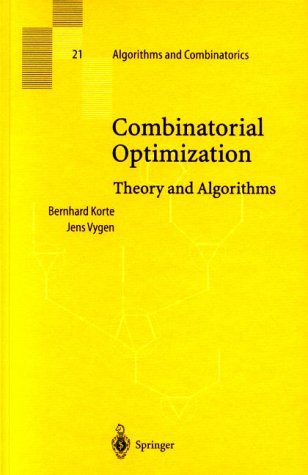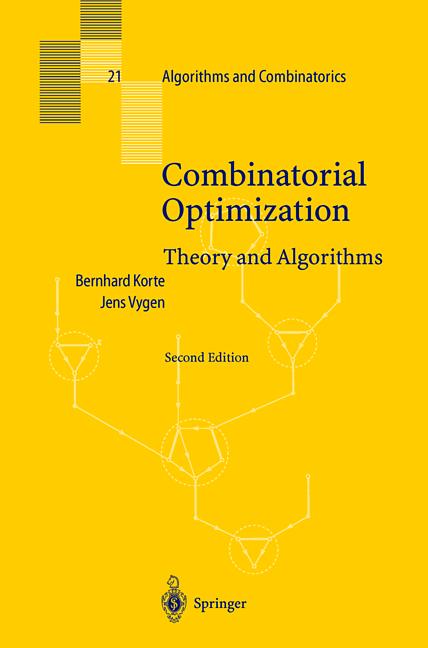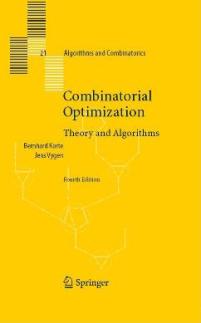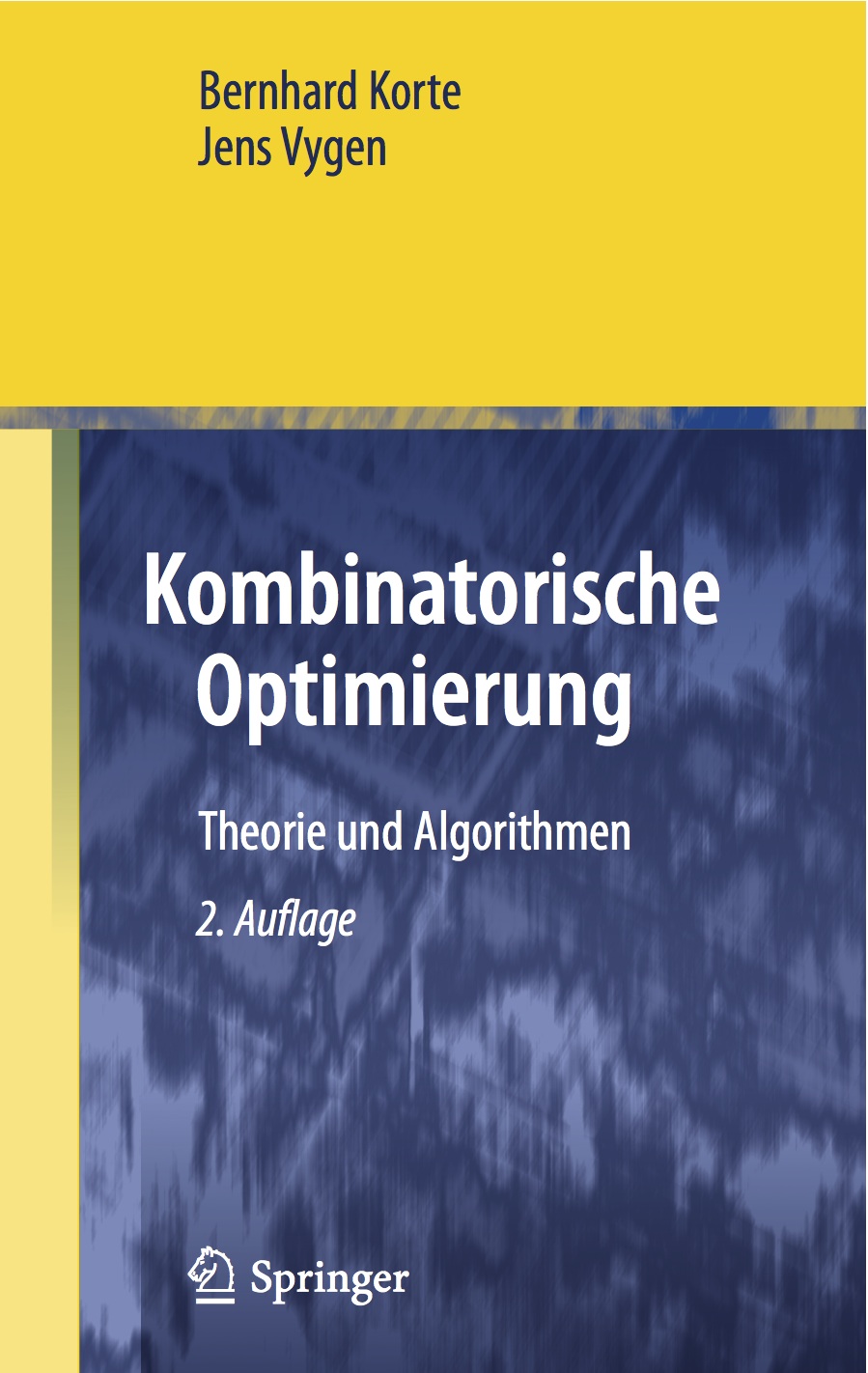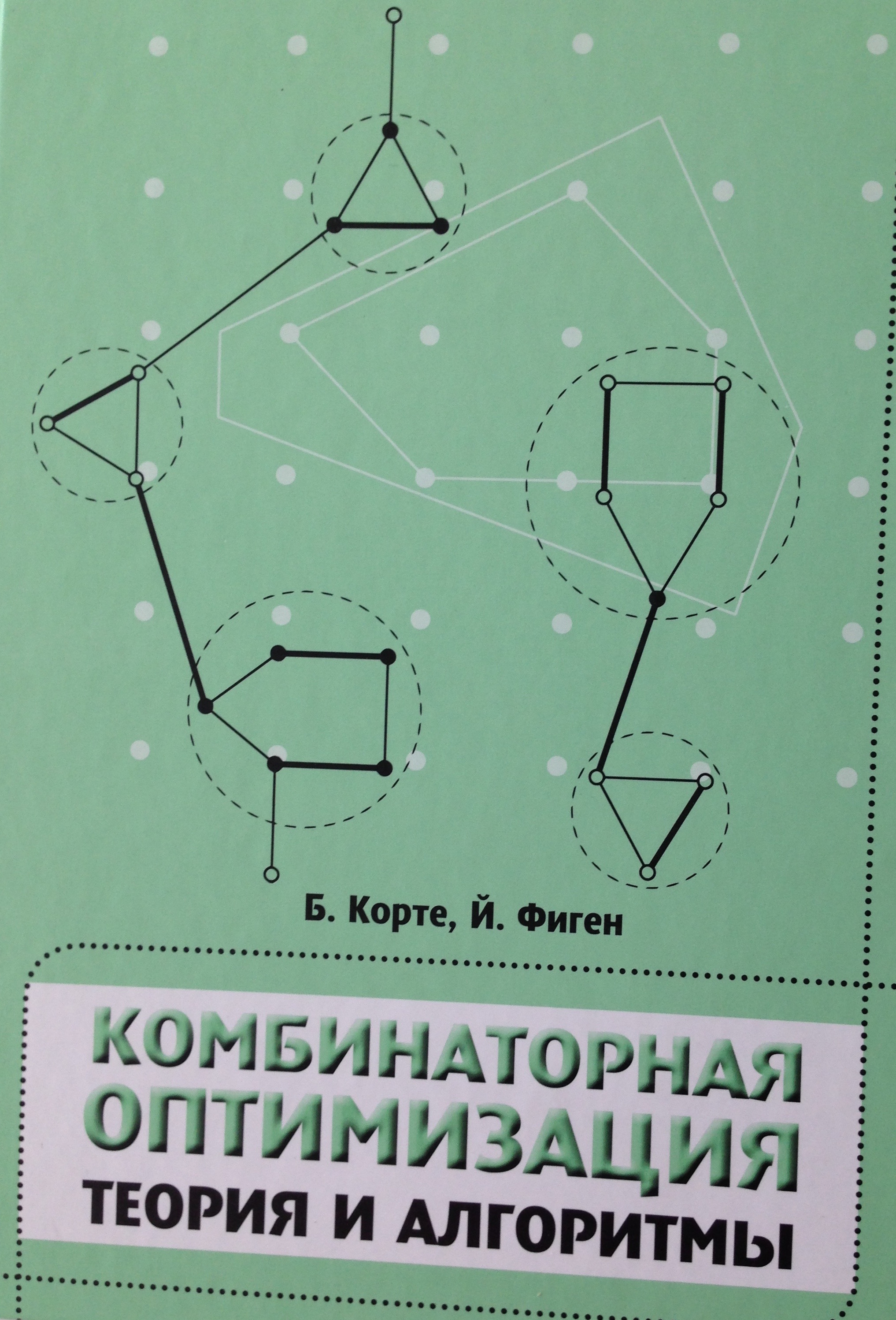| Page |
Line |
Comment |
| 18 | 41 |
We assume, w.l.o.g., that E(P) is not a subset of E(Q)
(otherwise exchange P and Q).
|
| 32 | 4 |
Replace W_1 by v_1.
|
| 32 | 11 |
Replace v by v_1.
|
| 124 | 2 |
Replace $C=\{...\}$ by $C$. The rows of the matrix $A$ in the Hint are $a_1,...,a_t$.
|
| 127 | 36-39 |
The paper by Dadush, Dey and Vielma [2011] appeared in
Mathematical Programming A 145 (2014), 327-348.
|
| 137 | 14-15 |
During DELETEMIN, one should take only vertices $u$ with $\delta^-(u)=\emptyset$ into consideration.
|
| 163 | 17 |
Chan's running time was improved by Han and Takaoka [2016] to
$O(n^3 \log\log n / \log^2 n)$. Reference:
Han, Y., and Takaoka, T. [2016]:
An O(n^3 log log n / log^2 n) time algorithm for all pairs shortest paths.
Journal of Discrete Algorithms 38-41 (2016), 9-19
|
| 186 | 26 |
Orlin [2013] found an $O(mn)$-time algorithm for the Maximum Flow Problem.
Reference: Orlin, J.B. [2013]: Max flows in $O(nm)$ time, or better.
Proceedings of the 45th Annual ACM Symposium on Theory of Computing (2013), 765-774.
|
| 197 | 4-7 |
Kawarabayashi and Thorup [2015] showed how to determine the edge-connectivity of a given graph in
$O(m\log^{12}n)$ time.
Reference: Kawarabayashi, K., and Thorup, M. [2015]:
Deterministic global minimum cut of a simple graph in near-linear time.
Proceedings of the 47th Annual ACM Symposium on Theory of Computing (2015), 665--674.
|
| 204 | 13 |
Exercise 35 works only for simple graphs.
|
| 206 | 40 |
The correct page numbers of the paper by Cheung, Lau and Leung [2011] are 197-206.
|
| 225 | 11 |
Replace "each by less than 2γ" by "adding up to less than 2γ(n-1)".
|
| 245 | 27 |
The coordinates should be independent.
|
| 267 | 1 |
Replace k by n.
|
| 268 | 26-30 |
Exercise 26 does not work; it is not clear how to update $\varphi$ fast enough.
|
| 298 | 41-43 |
A full version of Gabow's [1990] paper was published on arXiv:1611.07541.
|
| 346 | 28 |
Condition (b) should be weakened (for the application in the following proof):
we need c(xi)>c(yj) for i<j and
c(xi)≥c(yj) for i>j.
|
| 347 | 26 |
Replace x_1,...,x_l by x_l,...,x_1 and y_0,...,y_{l-1} by y_{l-1},...,y_0.
|
| 362 | 30 |
The proof should begin with the following:
Without loss of generality, $f(\emptyset) = g(\emptyset)$ and $f(E) = g(E)$.
|
| 369 | 14 |
Lee, Sidford and Wong [2015]
found a strongly polynomial-time algorithm that minimizes a submodular function in
$O(\gamma n^3 \log^2 n + n^4 \log^{O(1)} n)$ time.
Reference: Lee, Y.T., Sidford, A., and Wong, S.C.:
A faster cutting plane method and its implications for combinatorial and convex optimization.
Proceedings of the 56th Annual Symposium on Foundations of Computer Science (2015), to appear
|
| 371 | 23 |
The algorithm finds a maximal element $F$ of $\mathcal{F}$ with $c(F)$ maximum.
|
| 372 | 13 |
c should be strictly positive in Exercise 8.
|
| 378 | -3,-2 |
Replace Ĺ by Φ. Same on page 379, lines 2, 8, and 34, page 381, line 2,
page 384, line 31, page 390, lines 4 and 20, page 391, line 18, and page 407, line -3.
|
| 457 | 29-31 |
The paper by Singh and Lau appeared in the Journal of the ACM 62 (2015), Article 1.
|
| 475 | 3-9 |
Dósa and Sgall [2013] improved upper and lower bound of Theorem 18.6 to
$\lfloor\frac{17}{10}OPT(I)\rfloor$.
Reference: Dósa, G. and Sgall, J.:
First fit bin packing: a tight analysis.
Proceedings of the 30th International Symposium on Theoretical Aspects of Computer Science (2013), 538--549
|
| 486 | 36-39 |
The full version of the paper by Dósa [2007] appeared as follows:
Dósa, G., Li, R., Han, X., and Tuza, Z.:
Tight absolute bound for First Fit Descreasing bin-packing: $\textsl{FFD}(L)\le 11/9\, \textsl{OPT}(L) + 6/9$.
Theoretical Computer Science 510 (2013), 13--61
|
| 499 | 23 |
Replace $z_e$ by $z(e)$.
|
| 503 | 14 |
Replace $O(|E(H)|)$ by $O(\log |E(H)|)$.
|
| 511 | 30,32 |
Replace |\delta_H| by |\delta_G| in line 30 and |\delta_H(X)| by |\delta_G(Y)| in line 32.
|
| 519 | 4 |
The paper by Kawarabayashi, Kobayashi and Reed [2010] appeared in the
Journal of Combinatorial Theory B 102 (2012), 424-435.
|
| 523 | 37-38,40 |
The definition of $q(U\cup\{x\},x)$ is not good, as Lemma 20.4(a) may not hold in general.
To fix this, one can either require (w.l.o.g.) $c$ to be a metric or, easier, redefine
$q$ as follows:
$q(U\cup\{x\},x) :=
\min \{ c(E(S'))+c(E(S'')) : \emptyset \not= U'\subset U,
S' is a Steiner tree for U'\cup\{x\} in G,
S'' is a Steiner tree for (U\setminus U')\cup\{x\} in G \}$.
Then (a) is trivial, and the proof of (b) is essentially unchanged.
|
| 526 | 30-32 |
The Steiner tree inapproximability bound was improved to 1.01 by Chlebík and Chlebíková [2008].
Reference: Chlebík, M., and Chlebíková, J.:
The Steiner tree problem on graphs: Inapproximability results. Theoretical Computer Science 406 (2008), 207-214
|
| 529 | 15-20 |
The proof of the first statement is not entirely clear, but it actually shows the
stronger statement that there exists a spanning tree $M$
in $G[S]$ with $\sum_{\{s,t\}\in E(M)} dist_{(Y,c')}(s,t) \le c(E(Y))-c(L)$.
|
| 549 | 30-31 |
Replace ≤ by ≥ and one δG(A) by δG(B) in both lines.
|
| 553 | 2 |
Replace 0 by ∅.
|
| 554 | 19-21 |
The paper by Byrka et al. [2010] appeared in the
Journal of the ACM 60 (2013), Article 6, with the title:
Steiner tree approximation via iterative randomized rounding.
|
| 556 | 6 |
The correct title of Kou's [1990] paper is
"On efficient implementation of an approximation algorithm for the Steiner tree problem".
|
| 562 | 6-7 |
The TSP inapproximability bound was improved to 123/122 by Karpinski, Lampis and Schmied [2013].
Reference: Karpinski, M., Lampis, M., Schmied, R. [2013]:
New inapproximability bounds for TSP.
Algorithms and Computation; Proceedings of ISAAC 2013; LNCS 8283
(L. Cai, S.-W. Chen, T.-W. Lam, eds.),
Springer, Berlin 2013, pp. 568-578
|
| 590 | 22-25 |
The paper by Asadpour et al. [2010] appeared in Operations Research 65 (2017), 1043-1061.
Svensson, Tarnawski and Végh found a constant-factor approximation algorithm
(arXiv:1708.04215).
|
| 591 | 5-7 |
The paper by Englert, Röglin and Vöcking [2007] appeared in
Algorithmica 68 (2014), 190-264.
|
| 591 | 13-14 |
The paper by Fiorini et al. [2011] appeared in the
Journal of the ACM 62 (2015), Article 17, entitled
"Exponential lower bounds for polytopes in combinatorial optimization".
|
| 617 | 7 |
"element of" should be "subset of".
|
| 627 | 42-46 |
The paper by Levi, Shmoys and Swamy [2004] appeared in
Mathematical Programming A 131 (2012), 365-379.
|
| 627 | 47-50 |
The paper by Li [2011] appeared in
Information and Computation 222 (2013), 45-58.
|

